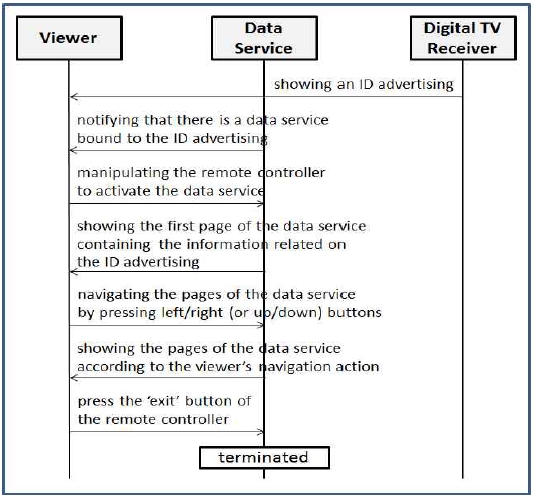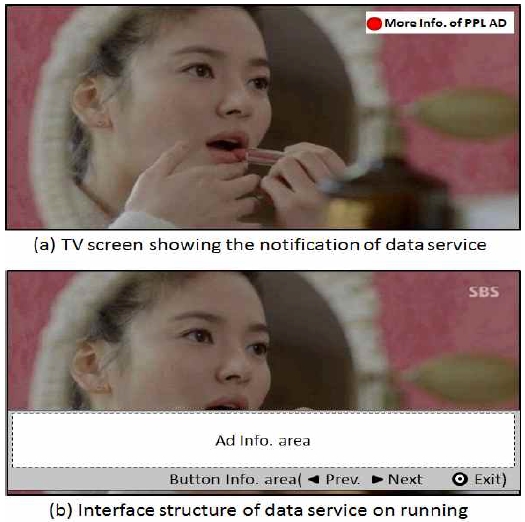
A Study on the TV Program bound Data Service providing Additional Information of PPL
Copyright ⓒ 2019 The Digital Contents Society
This is an Open Access article distributed under the terms of the Creative Commons Attribution Non-CommercialLicense(http://creativecommons.org/licenses/by-nc/3.0/) which permits unrestricted non-commercial use, distribution, and reproduction in any medium, provided the original work is properly cited.

Abstract
PPL (Product Placement) 광고는 프로그램 내용과의 자연스런 융합을 통한 친숙한 이미지 형성이라는 장점으로 인해 지속적인 성장 추세에 있지만 PPL광고 대상의 노출이 시청자의 반감 없이 이루어져야 한다는 제약 때문에 일반적으로 짧은 영상 노출 외에 광고 대상에 대한 정보를 제공하기 어렵다. 이 에, 본 논문은 디지털방송의 대표적인 기술인 데이터서비스를 통해 PPL광고 대상의 부가정보를 제공하는 방법을 연구하였다. 구체적으로, TV 시청행태의 특성을 고려한 데이터서비스의 인터페이스와 사용자 시나리오를 설계하였고, PPL광고 대상의 대표적 유형을 구별하여 유형별 핵심 부가정보를 정의하였으며, 프로그램 내에서 PPL광고 대상들의 노출시점 정보를 기술하는 방법을 고안하였다. 또한, 이 정보들을 국제 디지털방송 표준인 DVB (Digital Video Broadcasting)의 SI (Service Information) 테이블을 활용하여 데이터서비스에 제공하는 방법을 개발하였다. 본 연구는 기존 전형적인 광고에 데이터서비스 기술을 결합한 방송광고 산업의 새로운 성장전략을 제시한다는 점에서 의미가 있다.
초록
PPL (Product Placement) advertising is on a constant growth trend due to its advantages of familiar image formation through natural convergence with program content. However, it is generally difficult to provide information on advertising targets other than short video exposures because of the constraints that exposure to PPL targets should be performed without viewers' antipathy. In this paper, the method of providing additional information for PPL targets through data service, a representative technology of digital broadcasting, was studied. Specifically, the interface and user scenarios of the data service were designed considering the characteristics of TV viewing behaviors, key information by type was defined by distinguishing typical types of PPL targets, a method was devised to describe the exposure points of PPL targets within the program, and a method was developed to provide these information to the data service using the SI (Service Information) table of DVB (Digital Video Broadcasting), an international standard for digital broadcasting.
Keywords:
Digital Broadcasting, Data Service, PPL, DVB, Service Information키워드:
디지털 방송, 데이터서비스, 간접광고(PPL), DVB, 서비스 정보Ⅰ. Introduction
PPL (Product Placement) advertising is a type of indirect advertising, which means exposing commercial products or services to consumers in TV programs or movies after receiving monetary compensation from advertisers [1]. In general, PPL means companies expose their products to video, but in some cases, the government conducts publicity campaigns and public service campaigns through indirect advertising of TV programs (e.g, inserting a no-smoking campaign into SBS <Secret Garden> of the Ministry of Health and Welfare).
Until 2005, regulation of illegal PPL was a major issue due to the legal limitations of PPL advertisements[2]. However, as the share of terrestrial TV commercials in the advertising market declined from 40.5% in 2001 to 24.6% in 2008 and the cost of producing broadcasting programs increased due to the switching of digital broadcasting, the revision of the Broadcasting Service Act and the Enforcement Decree in 2009 allowed PPL and the introduction of PPL on terrestrial TV began in 2010 [3].
PPL has the advantage of being cheaper than conventional TV ads and being able to appeal familiar images to viewers, and solve the problem of ad avoidance through viewers' channel-jumping. In addition, overseas sales can be expected to increase due to overseas marketing effects caused by the export of contents. As examples, sales of Hyundai Motor's Tucson, which appeared in the KBS drama "Descendants of the Sun" in 2016, rose about 18 percent year-on-year as of March, and sales at Amorepacific's Laneige Two-Tone Lipbar, which the heroine wore during her play, rose 556 percent on-month as of March [4].
Despite the above advantages and achievements, there is a weakness that PPL cannot provide viewers with additional information other than a brief video exposure because of the restriction that the advertising targets should be naturally integrated with the program's content and be exposed without the viewer's antipathy.
To address the problem, this study devised a data service that provides additional information for targets promoted as PPL advertisements during program broadcasting. Specifically, data service user scenarios and interfaces were designed considering the characteristics of PPL ads that are exposed at any given short time during program broadcasting. We also defined the information of the PPL targets’ exposure point in the program and the additional information by type by distinguishing typical types of PPL targets. Then, we devised a method to transmit the information to the data service using SI (Service Information) protocol [5] of DVB (Digital Video Broadcasting) [6].
This study is meaningful in that it presents a new growth strategy of the broadcasting advertising industry that combines data service technology with existing typical advertisement as an environment in which the digital broadcasting era is settled and viewers gradually actively consume media.
Ⅱ. PPL Industry Trends
PPL is an advertising method that exposes products to consumers in TV programs and movies, and in a broad sense includes naturally exposing the image, name and location of a company in the context of the program [3]. PPL was allowed for terrestrial and paid broadcasting services in 2010 with the revision of the Enforcement Decree of the Broadcasting Service Act and continuously spreading in entertainment, culture and drama. In 2016, the Enforcement Decree of the Broadcasting Service Act was amended to allow outsourced producers to sell PPL advertisements [7].
The way in which PPL ads are sold is classified into five levels, depending on the level of exposure. Level 1 simply exposes brand as background, but level 5 can change not only background, character and brand, but also episode or storytelling configuration for PPL. PPL charges are based on the program's 15-second advertisement rate and audience rating along with the exposure level. <Table 1> shows PPL sales from 2016 to 2018 by terrestrial TV, cable PP, and broadcasting productions.
In terrestrial TV, PPL sales are also declining due to declining ad sales overall. However, it expects to increase by 2.8% in 2019. In cable PP and broadcasting companies, the annual sales of PPL advertisements increase by 32% and 10%, respectively, and PPL advertisements are developing as major advertising revenue sources.
Ⅲ. User Scenarios and Interfaces
When a program, to which the data service link, starts (or tunes to the program), a notice indicating the existence of the data service and how to execute it is output for 5 seconds on the right side of the TV screen. When the user executes the data service before the program ends, the additional information of the PPL target, currently exposed in the program, is provided at the bottom of the TV screen until the data service is intentionally terminated or the program is terminated or tuned to another channel. As the program progresses, the content of the additional information provided by the data service is continuously updated because the PPL targets change. Figure 1 shows a basic user scenario for this data service.
On the right side of the TV screen, the red button icon of the remote controller and 'More Info. of PPL AD' are exposed to inform the existence of the data service and how to execute it. When a viewer presses a red button on a remote controller, additional information on the PPL target, which is currently being exposed to the program, will be provided under the TV screen. The additional information output screen is divided into an <AD Info.> area showing the information of the PPL target and a <Button Info.> area showing the buttons for navigating and exiting the data service. Based on the research of [9], the interface of the data service is designed not to exceed 1/3 of the TV screen size and to have depth of 3 steps or less. (See Figure 2)
Ⅳ. Information of PPL Targets and Exposure Time
Because PPL exposes an advertising target at an arbitrarily short time, the data service should provide concisely the important content of the advertising target. To this end, based on the study in [3], the PPL targets were largely divided into 'Product’, ‘Place’, 'Company’, and 'Event’ types and the important additional information are defined for each type.
● Additional Information of the Product Type
The Product type includes the costumes, cars, various props, food and drinks that characters have or eat, and the services they use. This study defines important additional information of the Product type as product name, provider name, price, and advertising statement.
<PPL_ID> above is an ID that uniquely identifies this PPL target within the program.
● Additional Information of the Place Type
The Place type includes restaurants, parks, and travel destinations where location is the main information of interest from the viewer's perspective. In this study, the important additional information of the type are defined by place name, location, advertising statement, contact information.
● Additional Information of the Company Type
The Company type includes companies, government agencies and universities, which are mainly aiming at forming brands. This study defines important additional information of the type as business name, brand name, advertising statement, and contact information.
● Additional Information of the Event Type
The Event type includes the local festivals or the events in amusement parks. Because dramas or entertainment programs are recorded broadcasting, this study includes only the events that are held regularly every year. The important additional information of the type includes the event name, location, periodic opening period, advertising statement, and contact information.
It is common for PPL to include a number of advertising targets with different exposure points in the program. For example, in a drama, if a couple participates in a ‘Sancheoneo’ festival in the morning by car, eat lunch at a nice restaurant in the afternoon and buy a luxury bag at a department store in the evening, the car brands, the ‘Sancheoneo’ local festival, the restaurant and bag brands can be advertised as PPLs in order.
In order for the data service to provide additional information on PPL targets at the time of program exposure, this study defines the following information as to when the PPL target is exposed in the program.
<Program ID> is the unique ID of the program that contains this PPL targets, and <Period Offsets> is a pair of numbers indicating a period of seconds in which PPL targets are exposed. <PPL_ID> is the PPL target that is exposed in the period specified by the <Period Offsets>. The <PPL_ID> is the same concept as the one used in the additional information for each type of PPL targets.
Ⅴ. Information Supplying Method
EIT-P (Event Information Table-Present), one of the SI tables of DVB, an international standard for digital broadcasting, is used to supply the data service with additional information for each type of PPL targets and the exposure timing information defined in the previous chapter. The SI table is a protocol for transmitting information required by channel management and Electronic Program Guide (EPG). Since EIT-P, which is directly related to this study, is sent repeatedly within a short period of 500ms or less, it is advantageous to transmit information that should be sensitively synchronized at the beginning of the program. All SI tables, including EIT-P, support the concept of a 'descriptor' that can contain arbitrary information internally. This study defined the descriptors for containing the additional information and exposure time of PPL targets. These descriptors are included in EIT-P and transmitted to the data service along with the EIT-P.
PPL_Exposure_Time_Descriptor() contains the exposure point information in the program for PPL targets and is defined as in <Table 2>. The descriptor_tag, which is a descriptor identifier, has a value of 0x80 to 0xFE, which means that the descriptor is user-defined. The descriptor_ length indicates the size of the descriptor and the program_ID is the identifier of the program to which the PPL belongs. The offset_start_time and offset_end_time indicates a period in seconds where PPL exists, and the PPL_ID is the identifier of the PPL target exposed in this period.
Goods_PPL_Descriptor() contains the additional information of the Product typed PPL, and is defined as in <Table 3>. PPL_ID is the identifier of the PPL target that is uniquely identified within the program, and since then, the product name, provider name, prices, and advertising statement are described in strings. In a similar way, <Table 4> through <Table 6> define the descriptors for containing the additional information of the Location, Company, and Event typed PPL, respectively.
The data service can identify PPL targets that are exposed at a point in time in the program from PPL_Exposure_Time_Descriptor(), and can extract additional information on the PPL targets from the descriptors containing the additional information by type of PPL targets.
Ⅵ. Conclusion
In this study, a data service that supports PPL was designed to provide additional information of PPL targets. The background of this study is that television has evolved into a computing platform capable of executing data services and an environment has been established where viewers can actively consume broadcasting contents. The user scenario and user interface of the data service were designed considering the characteristics of the TV platform, and additional information was defined by distinguishing typical types of PPL targets such as the product, place, company, and event types. In addition, the information on the exposure points of PPL targets in the program was defined. Using the information, the data service can expose the information of a PPL target at the time the PPL target appears in the program. A method was also devised to supply this information to the data service using the DVB-SI tables.
Properly designed PPL serves as a medium that gives viewers a strong interest in advertising targets and a strong curiosity about relevant information [10]. In fact, the study on this data service was attributed to the characteristics of PPL. Afterwards, a prototype of the data service will be developed to validate the appropriateness of user scenarios and interfaces, and the utility of the data service from the perspective of the actual viewers.
Acknowledgments
This research is based on the support of 『2019 Woosong University Academic Research Funding』
References
- Korea Advertising Society Home Page: http://www.koads.or.kr
-
Han, Kyoo-Hoon and Moon, Jang Ho, “Directions for Regulating Product Placement in Korean Broadcasting Programs - Based on Case Analyses of Regulations in Foreign Countries,” The journal of Advertising Research, No. 104, 2015.
[https://doi.org/10.16914/ar.2015.104.109]

- K. H. Lee, “Drama PPL and Storytelling: using Example of <Secrete Garden>,” KOCCA Focus, Vol. 32, No. 2011-04, Korea Creative Content Agency, 2011.
- B. S. Hong, “PPL Market Status and Implications,” DIGIECO, Issue&Trend, 2018.
- "Digital Video Broadcasting (DVB): Specification for Service Information (SI) in DVB systems,” ETSI EN 300 468, v1.15.1, 2016.
- “ETSI EN 301 192 v1.4.2: DVB specification for data broadcasting," ETSI, DVB, 2008.
- S. K. Byeon, “Issues related to Introduction of New Type Advertising: Focus on PPL Issues,” Technical Report of Korea Association for Telecommunications Polices, 2009.
- “2018 Survey Report of Broadcasting and Communications Advertising Expense,” ISSN 2586-3894, KOBACO, 2018.
-
Kwangil KO, “A Data Broadcasting Service Design Guideline based on the Survey on Viewer’s Modality of Using Data Broadcasting Services” The Journal of Korea Game Society, Vol. 12, No. 6, 2012.
[https://doi.org/10.7583/JKGS.2012.12.6.25]

- Kwangil KO, “A TV Viewer's Modality-based Searching System Designed for Running on TV Set," The Journal of Digital Contents Society, Vol. 11, No. 3, 2010.

1995년 : 포항공과대학교 전자계산학과 (학사, 석사)
1999년 : 포항공과대학교 컴퓨터공학과 (공학박사)
1999년~2010년 8월: (주)알티캐스트 사업품질관리본부 본부장 및 서비스개발사업팀 팀장
2010년 9월~현재: 우송대학교 테크노미디어융합학부 영상콘텐츠전공 교수
※관심분야: 디지털방송 소프트웨어, 스마트TV방송UI/UX, 소프트웨어공학, 요구분석공학, N-스크린 서비스, 소프트웨어 교육


